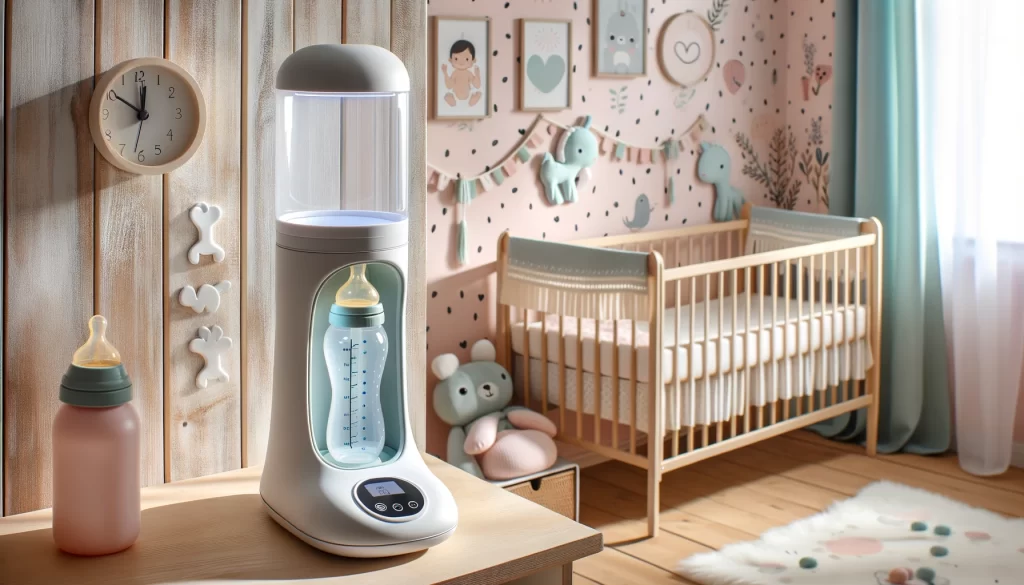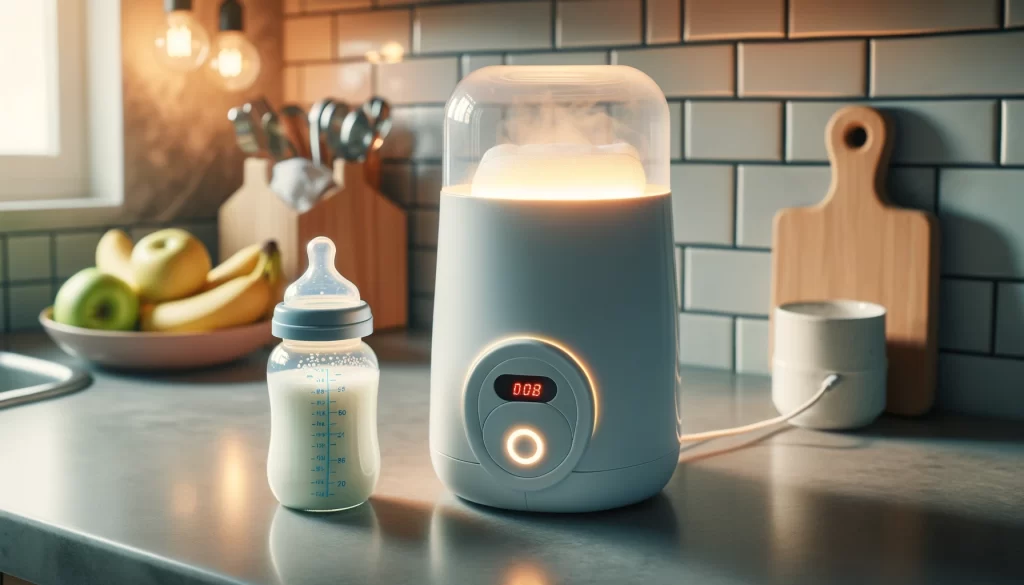Whether you're a new parent or simply someone looking for a more convenient way to handle baby feedings, a bottle warmer can be an invaluable addition to your arsenal of baby gear. This handy gadget efficiently heats up bottles to the perfect temperature, making feedings smoother and quicker. It can be especially useful for late-night feedings when both you and your baby are tired and looking for a fuss-free experience.
What is a Bottle Warmer?
A bottle warmer is a device designed to heat a baby's milk or formula to the ideal temperature, typically between 98°F and 100°F, quickly and evenly. They come in various shapes and sizes but generally feature a chamber where the bottle is placed, and a heating element that warms the liquid inside. The goal is to heat the milk to the ideal temperature that is both safe and comfortable for the baby.
The Benefits of Using a Bottle Warmer
While some may argue that this device is more of a luxury than a necessity, the benefits it provides could make it an invaluable addition to your parenting toolkit:
Time-Saving and Efficient
One of the most obvious benefits of using a bottle warmer is the time it saves. Traditional methods of warming a bottle—like holding it under running warm water or placing it in a bowl of warm water—can be incredibly time-consuming. And let’s be honest, when your baby is wailing at 3 a.m., every second feels like an eternity. Most bottle warmers can heat milk to the desired temperature in a matter of minutes or even seconds, depending on the model.
Consistent Heating
Microwaving is fast, but it’s not recommended for warming baby bottles. This is because microwaves do not heat liquids uniformly, creating "hot spots" that could scald a baby's mouth. With a bottle warmer, you can ensure that the milk is heated evenly throughout, thus reducing the risk of burns or discomfort for your little one.
Nutrient Preservation
When it comes to breast milk, every drop is like liquid gold—packed with nutrients and antibodies essential for your baby’s development. High heat levels can degrade some of these nutrients. Bottle warmers that use a water bath are especially good at preserving the quality of breast milk because they heat the milk slowly and evenly.
Versatility
Most modern bottle warmers are versatile enough to accommodate different types and sizes of bottles, whether they are made of glass or plastic. Some models also come with inserts that allow you to heat baby food jars, giving you more bang for your buck as your child grows.
Convenience and User-Friendly
Many bottle warmers come with a range of user-friendly features designed to make your life easier. For example, some models have a built-in timer so you can set it and forget it, freeing you up to do other things. Others offer an auto shut-off function for added safety. Some premium models even have smart capabilities, allowing you to control settings via your smartphone.
Travel-Friendly Options
For families that are always on the move, portable bottle warmers are available. These can be charged ahead of time or plugged into a car’s 12V socket, ensuring that you can warm a bottle wherever you go. This is especially beneficial during long journeys or outings, saving you the hassle of searching for a place to heat a bottle.
Aids Nighttime Feedings
Let’s face it: nighttime feedings can be a struggle. Anything that simplifies the process is a win in any parent’s book. Some bottle warmers come with a cooler section that keeps a bottle cold until you’re ready to heat it. This means you can prepare a bottle before going to bed and have it ready for when the baby wakes up. Many models also have a nightlight feature, so you can operate them without turning on bright overhead lights, keeping the room’s atmosphere calm and conducive to going back to sleep.
Economic Value
While a bottle warmer is an additional cost, the convenience and time-saving aspects can offer good economic value in the long run. High-quality models are generally durable and can last through multiple kids, making it a one-time investment for years of ease and convenience.
Exploring the Different Types of Bottle Warmers
When it comes to bottle warmers, it's not a one-size-fits-all scenario. As the demand for this convenient device has grown, so has the range of options available on the market. With so many types to choose from, picking the right one can be daunting for new parents or those unfamiliar with the product:

Electric Bottle Warmers
Features
Electric bottle warmers are the most common type and the one you're most likely to encounter when you start your search. They're designed to plug into an electrical outlet and come with various settings to warm your baby's bottle to the desired temperature.
Pros
- Quick and efficient
- Multiple settings for customized warming
- Often come with additional features like timers and automatic shut-off
Cons
- Must be near an electrical outlet, making them less portable
- Some models can be bulky
Ideal For
- Regular home use
- Families who need to warm bottles frequently
Water Bath Warmers
Features
A subset of electric bottle warmers, these warmers use a water bath to gradually heat the bottle. The method is similar to a sous-vide machine, where water circulates around the bottle to warm it evenly.
Pros
- Gentle and even heating
- Better at preserving the nutrients in breast milk
- Can often accommodate different types and sizes of bottles
Cons
- Typically slower than direct-heat electric warmers
Ideal For
- Parents who primarily use breast milk
- Those looking for a more gentle warming method
Car Bottle Warmers
Features
Car bottle warmers are designed for on-the-go convenience. They usually plug into a car’s 12V socket and can be a lifesaver on road trips or long outings.
Pros
- Portable and convenient for travel
- Quick and straightforward operation
Cons
- Limited to car use unless you have an adapter
- May not offer as many features as home-based electric models
Ideal For
- Families who are often on the go
- Road trips and outings
Flask-Type Bottle Warmers
Features
Flask-type bottle warmers consist of a thermal flask that keeps hot water hot for several hours. When you need to warm a bottle, you pour the hot water into a container that holds the bottle.
Pros
- No electricity needed, making it highly portable
- Can be used anywhere, anytime
Cons
- May require pre-planning to fill the flask with hot water
- Not as quick as electric or car bottle warmers
Ideal For
- Outdoor activities like camping
- Situations where electricity is unavailable
Multipurpose Bottle Warmers
Features
These bottle warmers can warm bottles and also sterilize them. Some even have a setting to steam-cook baby food.
Pros
- Versatile and multi-functional
- Saves counter space by combining several appliances in one
Cons
- Can be more expensive than single-function units
- May have a steeper learning curve due to multiple features
Ideal For
- Parents looking for an all-in-one solution
- Smaller kitchens with limited counter space
Smart Bottle Warmers
Features
Smart bottle warmers connect to your smartphone via an app, allowing you to control and monitor the warming process remotely.
Pros
- High level of control and customization
- Convenient for tech-savvy parents
Cons
- Generally more expensive
- Dependent on a stable Wi-Fi connection
Ideal For
- Tech-savvy parents who enjoy smart home integration
- Those willing to invest in advanced features for convenience
How long can you leave milk in a bottle warmer?
When it comes to leaving milk in a bottle warmer, it's important to adhere to safe guidelines to ensure that the milk remains suitable for consumption. The general rule is to not leave milk in a bottle warmer for more than one hour. This guideline is especially critical for breast milk, which can quickly develop harmful bacteria when left at room temperature or warmer for extended periods. Bottle warmers are designed to get milk to an ideal temperature for feeding but are not meant to store or keep milk warm for long durations. Prolonged exposure to heat can not only degrade the quality and nutritional value of the milk but also increase the risk of bacterial growth.

For formula milk, the one-hour rule applies as well. If the bottle has been in the warmer for more than an hour, it's best to discard the milk to ensure your baby's safety. Formula tends to spoil faster than other types of milk and can be a breeding ground for bacteria if left at a warm temperature for too long. Most manufacturers and pediatricians recommend preparing a fresh bottle of formula for each feeding to minimize any risks.
If you're dealing with situations where you may not be able to feed your baby immediately after warming the bottle, some bottle warmers come with a 'keep warm' feature. While this can maintain the temperature for a slightly longer period, it's still advisable to adhere to the one-hour rule for maximum safety and nutritional benefit. Always remember to test the milk's temperature before feeding your baby, and when in doubt, it's better to prepare a fresh bottle than to use one that's been sitting in the warmer for an extended period.
Are Bottle Warmers Safe?
The question of whether bottle warmers are safe is a common concern for many parents and caregivers. Generally speaking, modern bottle warmers are designed with safety in mind and come equipped with features like auto-shutoff mechanisms, timers, and sometimes even alarms to notify you when the warming cycle is complete. These features are intended to prevent overheating of the milk and to minimize the risk of burns or other accidents. Moreover, most bottle warmers on the market are made from BPA-free, FDA-approved materials, providing an additional layer of safety.
However, like any electrical appliance, the safety of a bottle warmer is closely tied to its proper usage. Reading and following the manufacturer's guidelines is crucial for ensuring safe operation. This includes not only how to use the bottle warmer but also how to clean and maintain it to prevent bacterial growth or residue build-up. Furthermore, it's crucial to always test the temperature of the milk before feeding it to your baby, even if your bottle warmer has an auto-shutoff feature. This additional step can provide peace of mind and confirm that the milk is at a comfortable temperature for your baby to drink.
In conclusion, a bottle warmer can be a valuable addition to your baby-care essentials, offering advantages that range from time-saving convenience to consistent, safe heating. With various types available, including electric, water bath, and portable options, you're likely to find a model that perfectly suits your lifestyle and needs. While not an absolute necessity, the ease and efficiency provided by a bottle warmer can make those countless feedings a little less daunting and a lot more manageable. Whether you're a new parent or a seasoned caregiver, investing in this handy gadget could simplify your life in ways you hadn't imagined.




